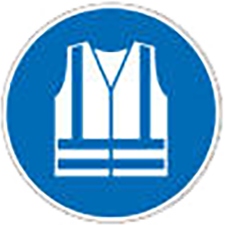The Importance of PPE in Reducing Workplace Injuries.
Personal protective equipment (PPE) is essential for protecting workers from potential hazards at work. PPE has the potential to stop diseases, injuries, and even deaths when used properly. HSE reported that in the year 2022/23 there were a staggering 561,000 non-fatal injuries in the UK workplace.
This article looks at case studies from a variety of PPE categories to demonstrate the essential role that PPE plays in reducing accidents at work.
- Page Contents
- PPE: The Last Line of Defence
- The Role of Head Protection in Preventing Fatalities
- Eye Protection in Manufacturing
- Hearing Protection in Construction
- Respiratory Protection in Construction
- Hand Protection in the Warehousing Sector
- Safety Footwear Prevents Major Injury
- Hi Vis Clothing Reduces Accidents Near Roadways
- Conclusion
PPE: The Last Line of Defence
When controls and appropriate work practices aren't enough to entirely remove dangers, personal protective equipment (PPE) steps in as a last resort. PPE can reduce the chance of personal harm even if it can't eradicate hazards.
To be effective, PPE must be selected, used correctly, and maintained on a regular basis.
PPE Guides
The Role of Head Protection in Preventing Fatalities
In 2017, a construction worker was hit by falling scaffolding debris at a building site in the UK. He avoided a possibly catastrophic head injury because his hard hat absorbed the force. The key to the hard hat's success was that it was well-fitting and in good condition, both of which were necessary given its high-impact resistance. This incident highlights the critical need for PPE inspections and safety checks to be mandated on building sites.
The Health and Safety Executive (HSE) reported that in 2019, 30 fatalities in the construction industry were caused by being injured by falling or moving objects. With proper head protection, the majority of these injuries could have been avoided.
The hard hat in this case performed as intended, illustrating potential for saving lives when using PPE appropriately.
Eye Protection in Manufacturing
While running machinery in a UK manufacturing company, a worker suffered minor injuries caused by metal shavings that flew towards his face. Luckily, he had on the compulsory safety goggles, which kept the debris away from his eyes. The goggles provided sufficient protection against flying particles since they were constructed of impact-resistant materials and complied with UK safety regulations.
Eye protection is often overlooked but is critical in environments where small debris can cause serious damage. In the UK, more than 2,000 eye injuries occur every year in workplaces, many of which are preventable with appropriate PPE.
Case studies published by the HSE show how routine inspections and training in the correct use of eye protection can prevent these types of injuries.
Hearing Protection in Construction
A worker operating a pneumatic hammer on a construction site in the UK developed permanent hearing loss due to insufficient use of hearing protection. Despite the worksite’s noise levels exceeding 85dB, the employer had not enforced the use of hearing protection, and workers were left to decide for themselves when to use it.
According to HSE statistics from 2022, more than 11,000 workers have noise-induced hearing loss (NIHL), a disease that may be entirely avoided with the use of appropriate hearing protection. Ear protection, such as earplugs or ear defenders, is required in workplaces where employees are subjected to high noise all the time in order to lower the risk of hearing impairment.
When noise levels surpass 85dB, employers are required under the Control of Noise at Work Regulations to provide appropriate hearing protection. Failure to do so can have irreversible consequences, as seen in this case.
Respiratory Protection in Construction
In many different sectors, there is a considerable danger of exposure to toxic chemicals and dust particles. A UK construction worker who had been exposed to silica dust for years without wearing proper respiratory protection was diagnosed with silicosis in 2018. The employee developed long-term health issues as a result of being supplied with dust masks that did not adhere to the necessary FFP3 requirements.
The HSE claims that exposure to silica dust causes over 500 fatalities in the construction sector every year. Reducing respiratory hazards requires powered respirators or FFP3 masks fitted properly.
Hand Protection in the Warehousing Sector
A UK warehouse worker who handled sharp materials in 2020 narrowly avoided suffering a serious injury. Cut-resistant gloves were given to the worker to prevent cuts on his hands. The worker may have suffered long recovery times and even permanent injury in the absence of these gloves.
According to the HSE, 20% or more of non-fatal injuries in the logistics and warehousing industries are hand injuries, including cuts and abrasions.
Whether choosing a glove for impact, chemical, or cut protection, choosing an appropriate type is essential to minimising the risk of hand injuries.
Safety Footwear Prevents Major Injury
A worker at a warehouse in the United Kingdom escaped serious harm when a large container fell and landed on his his toe-capped boots. The worker's toes would have been crushed without this protection. The incident highlights the importance of wearing safety footwear that complies with EN ISO 20345 in areas where there is a danger of large objects falling or rolling.
According to the HSE, foot injuries are frequent in industries including construction and warehousing and are frequently caused by falling objects or machinery. The correct safety footwear for the working environment reduce these risks dramatically. This guide from the TUC may help you make the right decisions.
Hi Vis Clothing Reduces Accidents Near Roadways
In 2018, a UK roadworker was struck by a vehicle due to poor visibility on a rainy day. This incident could have been fatal, but the worker’s Hi Vis jacket, compliant with EN ISO 20471, significantly improved their visibility, leading to quick evasive action by the driver.
The HSE stresses that Hi Vis clothing is essential for anyone working near vehicles or roadways. Without Hi Vis, workers blend into their environment, increasing the risk of accidents, particularly during low-light conditions.
Conclusion
These examples highlight the importance of using PPE to reduce workplace injuries. The right personal protective equipment (PPE) may be the difference between life and death in hazardous work environments. In accordance with UK regulations, employers are required to ensure the safety of their employees by providing and enforcing the usage of PPE.
Businesses can significantly reduce work-related injuries and fatalities by complying with HSE regulations and regularly reviewing PPE requirements.













